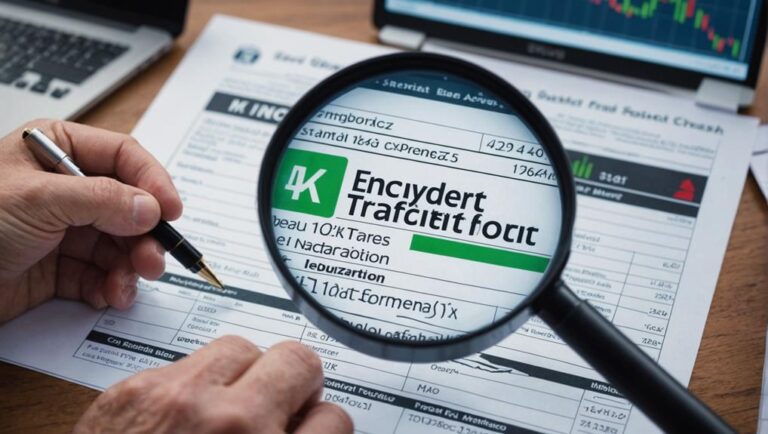The Role of SEC Form 4 in Regulating Insider Trading Activities

SEC Form 4 is a crucial tool in overseeing insider trading activities. By mandating that insiders promptly report their equity transactions, we ensure transparency and maintain investor trust.
Insiders are obligated to disclose specific details such as changes in ownership and the types of securities involved, even those held indirectly. These Form 4 submissions, which can be accessed via the SEC's EDGAR system, play a vital role in preventing fraudulent practices and upholding the integrity of the market.
Failure to meet the filing deadlines can result in severe penalties and damage the individuals' reputations. The intricate transaction data provided in these filings assists in predicting stock movements, giving investors the knowledge needed to make well-informed decisions.
To grasp the full impact of Form 4 on the financial landscape, further exploration is warranted.
Key Takeaways
SEC Form 4 enforces immediate disclosure of insider transactions, promoting transparency in the market. It specifies alterations in ownership and the types of securities involved, aiding in the surveillance of insider activities. By adhering to filing deadlines, it guarantees timely access to crucial information for investors, preventing any potential information asymmetry.
Failure to comply with SEC Form 4 regulations can result in severe penalties and harm reputations, serving as a deterrent against any fraudulent activities by insiders. The detailed transaction data provided by this form enables investors to adjust their strategies according to insider sentiment, potentially influencing their investment decisions.
Overview of SEC Form 4
Understanding SEC Form 4 is crucial for monitoring insider trading activities and promoting transparency in the securities market. This form, mandated by the SEC, compels directors, officers, and beneficial owners of stock to divulge their securities transactions. It's not merely a formality; it's a fundamental tool in our pursuit of clear and equitable markets.
Insiders are required to file SEC Form 4 within two business days when they buy or sell shares. This disclosure includes vital information such as the transaction date, type of security, and the number of shares involved. By following these reporting guidelines, insiders assist us in monitoring changes in beneficial ownership, preventing any covert attempts to influence market prices through undisclosed trades.
Furthermore, SEC Form 4 extends beyond direct ownership. Insiders must also disclose indirect ownership through trusts or accounts, enriching our ability to track intricate securities transactions. Investors, always seeking valuable insights, can utilize this data to assess insider sentiment and behaviors towards a company.
In essence, SEC Form 4 acts as a beacon of transparency in the sometimes opaque realm of insider trading. It's not just about meeting regulatory requirements; it's about cultivating trust and assurance in our financial markets.
Importance of Transparency
Transparency in securities transactions, as facilitated by SEC Form 4, is crucial for upholding investor confidence and ensuring equitable market practices. By revealing insider transactions, Form 4 boosts transparency, enabling investors to monitor ownership alterations involving significant company figures such as directors, officers, and beneficial stock owners. This oversight acts as a deterrent to insider trading and fosters accountability.
Form 4 mandates that insiders report ownership changes of 10% or more within two business days, in compliance with stringent SEC regulations. The form discloses vital transaction specifics, including the security type, the quantity of shares bought or sold, and the remaining shares. This wealth of information provides essential investor insights, empowering us to assess insider sentiment and make well-informed investment choices.
Transparency plays a fundamental role in maintaining the integrity of our financial markets, guaranteeing that all participants compete on an equitable basis. Here's a snapshot of how the details in Form 4 instill confidence:
| Insider Name | Transaction Type | Shares Bought/Sold |
|---|---|---|
| John Doe | Purchase | 5,000 |
| Jane Smith | Sale | 2,000 |
| Robert Brown | Purchase | 3,500 |
| Emily Davis | Sale | 4,000 |
This table demonstrates the transparency and clarity provided by Form 4, nurturing trust and enabling us to make informed financial decisions.
Insiders Required to File

Let's identify who qualifies as insiders and their obligations. Insiders include directors, officers, and beneficial owners. They must submit SEC Form 4 within two business days of any stock transaction to disclose ownership changes promptly.
Failure to meet these deadlines can result in significant consequences, such as financial penalties and legal action.
Definition of Insiders
Insiders who are mandated to submit Form 4 consist of directors, officers, and beneficial owners holding 10% or more of a company's outstanding shares. These key figures, due to their roles and substantial ownership stakes, possess considerable voting power and the ability to sway corporate decisions. Directors and officers, including the president, CFO, and VPs, typically hold pivotal positions that impact the strategic direction of the company.
Form 4 stands as a crucial instrument for transparency, going beyond mere regulatory compliance. Its primary purpose is to ensure that the market promptly receives information on the trading activities of insiders, individuals with unique insights into the company. Beneficial owners with significant voting rights or investment influence are obligated to disclose their transactions, thereby fostering a fairer environment for all investors.
The parties involved in this disclosure process are diverse. They encompass directors, who serve on the board and oversee governance; officers, such as the president and CFO, who play key roles in policy-making; and beneficial owners, who hold substantial voting power by owning 10% or more of the company's shares. Additionally, entities with indirect ownership interests, like trusts and partnerships, are also required to report their transactions through Form 4.
Ultimately, the aim is to promote a transparent market where all investors have equitable access to information.
Filing Deadline Requirements
To ensure prompt public disclosure of insider trading activities, insiders must submit SEC Form 4 within two business days of the transaction. This strict filing deadline is crucial for maintaining transparency in stock transactions and providing the public with up-to-date information.
Completing Form 4 accurately is essential to reflect any changes in ownership, whether from direct purchases, sales, or derivative securities.
The two-day timeframe is essential and aims to swiftly update the market, preventing any potential unfair advantages resulting from delayed disclosures. SEC Form 4 plays a vital role in our regulatory framework by ensuring that insider trading activities are promptly disclosed.
Timely public disclosure isn't merely a procedural requirement but a fundamental element of market integrity.
Failure to meet this filing deadline can lead to severe consequences, highlighting the importance of insiders adhering strictly to these timelines. By complying with the two-day requirement, we promote a culture of transparency and confidence within the financial markets. The accuracy and timeliness of these filings guarantee that all market participants operate on an equitable basis.
Consequences of Non-compliance
Failing to file SEC Form 4 within the mandated two-day deadline can result in significant penalties and enforcement actions. As insiders, we're legally obligated to promptly report our transactions to comply with insider trading regulations.
Non-compliance with Form 4 filing requirements isn't just an oversight; it can lead to late filing penalties that have a direct impact on our professional and financial standing.
When the deadline is missed, the SEC may initiate enforcement actions, which can result in fines or other legal consequences. These penalties aren't just critical; inaccurate filings also pose substantial risks.
Ensuring the accuracy and timeliness of insider transactions on Form 4 is crucial for maintaining regulatory compliance and avoiding severe repercussions.
The SEC's close monitoring means that any deviation from the norm, whether it be a late filing or errors in reported data, can attract attention and lead to penalties for inaccurate filings.
By promptly filing Form 4 and ensuring the information is correct, we can reduce these risks and demonstrate our dedication to ethical and transparent business practices.
Let's innovate by incorporating robust compliance systems that proactively address these legal requirements, protecting our operations and reputation.
What Must Be Disclosed
We need to disclose detailed information regarding insider transactions, such as the dates, types of securities, and the quantity of shares bought or sold. Furthermore, any alterations in ownership, encompassing indirect ownership through trusts or accounts, must be reported.
Filing promptly within two business days is crucial to uphold transparency and comply with SEC regulations.
Insider Transaction Details
Form 4's disclosure of insider transaction details ensures that investors receive a complete overview of the types of securities involved, transaction dates, and the number of shares bought or sold. This mandatory disclosure system promotes transparency and builds confidence in the market.
Each Form 4 submission precisely specifies whether the transaction pertains to common stock, preferred stock, or derivative securities, along with the exact transaction date, providing a clear timeline of insider activities.
Insiders are required to report both direct and indirect ownership, including holdings through trusts or accounts, leaving no ownership unaccounted for. The reporting process involves detailing the shares bought or sold, categorized by the type of security, enabling investors to understand the nature of these transactions better.
Moreover, in cases involving derivative securities, Form 4 disclosures mandate reporting on conversion dates and the underlying securities involved, enhancing the level of detail provided.
Different roles or classes of securities necessitate separate lines in the form, offering a detailed insight into insider transactions. This detailed information empowers investors to make well-informed decisions, fostering a culture of accountability and innovation.
Ownership Changes Report
In the realm of insider trading regulation, it's crucial to provide detailed information about any ownership changes, including those involving derivative securities. Company insiders, like directors, officers, and beneficial owners, must submit Form 4 to report these changes. This form contains vital details on stock transactions, specifying the transaction dates, types of securities involved, the quantity of shares bought or sold, and the remaining shares held.
For Form 4 to effectively fulfill its regulatory role, it should cover all facets of ownership changes, even those related to indirect ownership through trusts or accounts. Accurate ownership disclosure enables investors to comprehend insider activities and evaluate their potential impact on the company's stock. Through reporting these changes, Form 4 ensures transparency and fosters trust in the market.
When company insiders partake in stock transactions, they must promptly disclose these activities, offering a clear view of their holdings and any alterations. This meticulous reporting helps uphold market integrity by preventing insider trading and promoting fairness. Investors can depend on these ownership disclosures to make informed choices, thus nurturing an innovative and transparent investment landscape.
Filing Deadlines Importance
Submitting Form 4 within two business days of an insider transaction is crucial for upholding market transparency and preventing fraudulent trading activities. This requirement ensures prompt disclosure of important details like the transaction date, type of security involved, shares bought or sold, and the remaining shares. By strictly adhering to these filing deadlines, we foster an environment where all investors have equal access to critical information regarding changes in beneficial ownership.
Form 4 not only covers direct transactions but also captures indirect ownership changes, such as those occurring through trusts or other accounts. This comprehensive disclosure serves as a vital tool in deterring insider trading by offering a transparent view of insiders' actions and intentions.
Investors can monitor these insider transactions on the SEC's EDGAR website, gaining valuable insights into the decisions and movements of individuals with intimate knowledge of the company.
Filing Deadlines

Meeting the two-business-day deadline for filing SEC Form 4 is crucial for ensuring transparency in insider trading activities. Insiders must file Form 4 within two business days of engaging in transactions to promptly inform the market. This form is essential for tracking insider trading and includes specific transaction details such as the type of security, transaction dates, unique codes, the number of shares traded, and the remaining shares. Additionally, it requires the disclosure of indirect ownership, such as securities held in trusts or other accounts.
Filing Form 4 through the Electronic Data Gathering, Analysis, and Retrieval (EDGAR) system is the preferred method as it provides real-time updates and easy public access. By filing through EDGAR, market participants can stay informed efficiently.
Form 4 filing requirements are designed to ensure that market participants have prompt awareness of insider trading activities. The details provided in Form 4, such as transaction dates and shares traded, contribute to market transparency. Moreover, the disclosure of indirect ownership in the form allows for comprehensive insight into insiders' holdings.
Real-time updates through the EDGAR filing system contribute to market efficiency by providing timely information to investors and regulators. This accessibility helps maintain the integrity of the market by enabling stakeholders to make informed decisions based on up-to-date insider trading activities.
How to Access Form 4
Accessing Form 4 is effortless through the SEC's EDGAR system, where investors can conveniently search for specific insiders or companies. This platform simplifies the process, making it easy to view the filed Form 4 disclosures. By utilizing the SEC's Electronic Data Gathering, Analysis, and Retrieval (EDGAR) system, we can stay informed about insider transactions and ownership changes, which are crucial for making well-informed investment decisions.
On the SEC's website, we've access to a plethora of information for regulatory purposes and transparency. The platform not only allows us to view current Form 4 filings but also enables us to explore historical filings. This feature provides a comprehensive view of insider activity over time, allowing us to track trends and patterns that may impact our investment strategies.
For individuals new to the system, the SEC's website offers detailed guidance on navigating and efficiently searching for Form 4 filings. This ensures that even novice investors can utilize this powerful tool to gain insights into insider transactions. By leveraging EDGAR, we can maintain an informed perspective on the market, aligning with our desire for innovative and strategic investment approaches.
Role in Preventing Fraud

Requiring prompt disclosure of insider transactions, SEC Form 4 plays a crucial role in preventing fraud and upholding market integrity. According to federal securities laws, insiders must submit Form 4 within two business days after a transaction occurs. This swift disclosure boosts transparency and monitors shifts in beneficial ownership, making it harder for insiders to manipulate the market without detection.
Let's delve into how Form 4 operates:
- Federal Securities Laws: Mandate the submission of Form 4 to oversee insider trading activities.
- Insider Trading: Provides visibility into insider buying and selling, discouraging unlawful behaviors.
- Transparency: Ensures timely disclosure of changes in beneficial ownership.
- Fraud Prevention: Aids in identifying and preventing market manipulation by monitoring insider actions.
Impact on Investors
Understanding the impact of SEC Form 4 on investors underscores its role in fostering transparency and aiding informed decision-making in the stock market. By monitoring insider transactions, we gain valuable insights into the trading activities of company executives and significant shareholders. This transparency empowers us to conduct thorough investor analysis and comprehend shifts in insider ownership and sentiment.
The prompt reporting obligation of Form 4, which requires disclosures within two business days, is crucial. It ensures that we have real-time information on insider behavior, enabling us to make well-informed decisions regarding our investments. This timely access to data can be a game-changer, allowing us to anticipate potential stock movements based on the actions of those with the most intimate knowledge of the company.
The detailed transaction data in Form 4 filings offers us a more profound understanding of insider actions, whether they involve buying or selling stock. This level of specificity supports our investment strategies, enabling us to align our decisions with insider sentiment.
Ultimately, Form 4 plays a pivotal role in upholding market integrity, ensuring that we, as investors, can navigate the complexities of the stock market with enhanced confidence and insight.
Consequences of Non-Compliance

Failure to comply with SEC Form 4 filing deadlines can have serious consequences. It can lead to significant penalties of up to $16,500 per violation, impacting our financial well-being and market reputation. Non-compliance also jeopardizes market transparency, which is essential for maintaining a level playing field for all investors and stakeholders.
When deadlines are missed, the SEC may initiate enforcement actions, subjecting us to thorough investigations that can uncover potential insider trading activities. These investigations not only consume resources but also pose a risk to our standing in the market. Inaccurate or incomplete Form 4 filings can tarnish our credibility and trustworthiness, which are crucial assets in the financial industry.
Ensuring timely and accurate Form 4 filings is essential to uphold transparency and integrity. By meeting these requirements, we not only avoid penalties but also contribute to a trustworthy market environment. Stakeholders rely on us to provide accurate and up-to-date information, and any deviation from this expectation can have long-lasting repercussions on our relationships and reputation.
In conclusion, adherence to SEC Form 4 filing requirements is paramount for safeguarding our market standing and credibility. By prioritizing compliance, we demonstrate our commitment to transparency and integrity, fostering trust among investors and stakeholders.
Let's stay vigilant in meeting these obligations to avoid the pitfalls of non-compliance and protect our reputation in the financial market.
Frequently Asked Questions
What Is the Purpose of SEC Form 4?
We file SEC Form 4 to disclose insider transactions, ensuring transparency in executive compensation and stock ownership. Adhering to filing deadlines and reporting requirements enhances trading disclosures and improves corporate governance, fostering innovation and trust. This form is essential for investors and regulators to monitor changes in ownership of company stock by insiders, providing crucial insights into potential conflicts of interest and market dynamics. By promoting accountability and integrity in financial markets, Form 4 plays a key role in upholding the principles of fair disclosure and investor protection.
For What Purpose Is the Sec's Registration Form S 4 Used?
Let's delve into the purpose of the SEC's Registration Form S-4. This form specifically addresses the registration requirements related to corporate mergers, exchange offers, business combinations, share transfers, and securities issuance. By utilizing Form S-4, companies ensure that they meet their reporting obligations, promoting transparency and compliance with regulatory standards.
Form S-4 is crucial for companies engaging in activities such as mergers, acquisitions, and other significant transactions that involve the issuance of securities. It plays a key role in providing investors and regulators with essential information about these transactions, ensuring that shareholders are well-informed about any potential changes in ownership or control of the company.
How Does the SEC Regulate Insider Trading?
We enforce insider trading regulations through enforcement actions, robust compliance programs, and whistleblower protections. The SEC Form 4 is a crucial tool in this process, requiring the disclosure of changes in ownership of company stock by insiders. By clearly defining who qualifies as insiders and establishing trading windows for them, we can closely monitor market activity and ensure fair and transparent trading practices. Violators face strict penalty structures to uphold market integrity and promote a level playing field for all investors.
What Is SEC Form F 4?
When we delve into SEC Form 4, we're delving into SEC filings that ensure transparency in ownership and monitor transactions by executives. This trading transparency is crucial for insider compliance, upholding market integrity, and meeting regulatory obligations. SEC Form 4 specifically focuses on the required disclosure of changes in ownership of company stock by insiders, providing a clear record of these transactions for investors and regulatory bodies. It plays a vital role in maintaining transparency and accountability in the financial markets.
Conclusion
SEC Form 4 serves as a crucial tool in overseeing insider trading activities. It stands as a beacon of transparency in the complex realm of stock transactions. Picture it as a guiding light leading investors through the potential pitfalls of fraud.
With its mandate for prompt and comprehensive disclosures, Form 4 nurtures trust and upholds the integrity of the market. When insiders adhere to these regulations, it operates like a well-organized system, ensuring that all participants abide by the established rules.
Remember, failure to comply isn't just a mere mistake; it signifies a breach of trust that can result in severe consequences.






